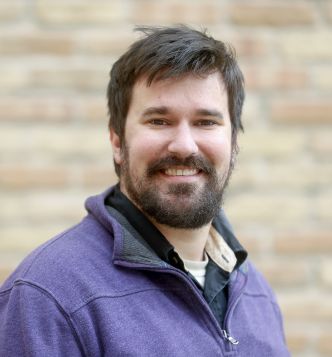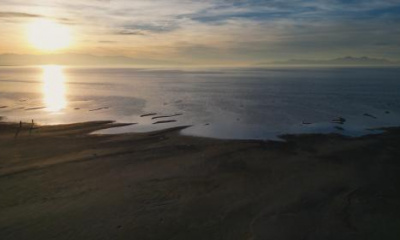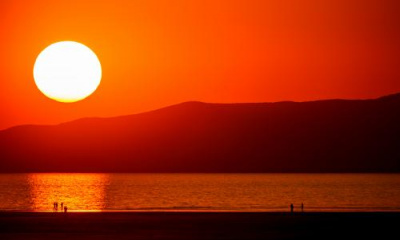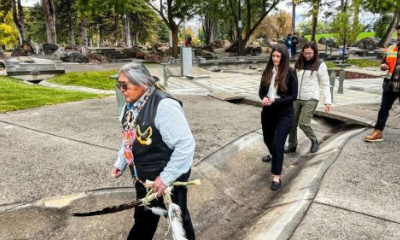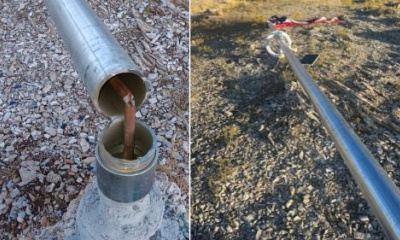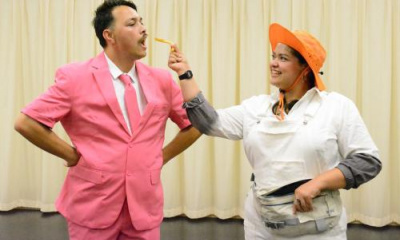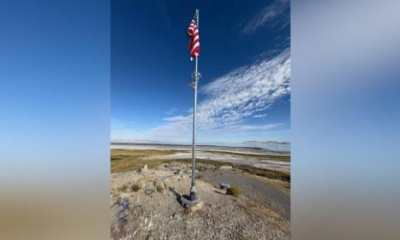SALT LAKE CITY — Scholars, politicians and environmental groups have all written and spoken about Great Salt Lake's importance, but Utah's capital city is now a step closer to using art to draw attention to the lake's recent struggles.
Salt Lake City Arts Council members announced Tuesday they've selected a dozen local artists and groups to participate in "Wake the Great Salt Lake," a temporary art program that aims to address concerns over the lake's future. Felicia Baca, executive director at the Salt Lake City Arts Council, said the council received over 120 proposals for the project, which she said shows how Utah's artists embraced the idea with "passion and creativity."
The winning projects range from artistic projections along downtown buildings to theatrical performances, and many ideas in between.
"The selected projects will engage audiences of all ages across the city and bring diverse perspectives to the issues, science and solutions surrounding the decline of Great Salt Lake," Baca said.
Local 'Wake the Great Salt Lake' Projects
Individual artists
- Kellie Bornhoft: An "interactive sculptural installation" that will honor the plants, wildlife and organisms that live within the Great Salt Lake ecosystem through illustrations printed on fabric banners.
- Nicholas Carpenter: A mobile phone booth where visitors can use a dial-in hotline to record their thoughts on the Great Salt Lake. These can be stories about their experiences with the lake or their "hopes and fears" about its future.
- Trevor Dahl: "Cartoon surrealism" is used to depict a "colorful, detailed and positive vision" of the lake that seeks to inspire visitors to want to protect the Great Salt Lake.
- Stefan Lesueur: A sound installation to play recordings of the Salt Lake Valley's streams — tributaries for the Great Salt Lake — and community stories about the Great Salt Lake watershed. This will be installed at the Seven Canyons Fountain in Liberty Park, which is in the process of being converted into a "dry" art feature.
- Nick Pedersen: A digital collage to depict "two possible futures for the Great Salt Lake ecosystem" on opposing billboards. The billboard will be placed along "a major thoroughfare" within the Poplar Grove neighborhood.
- Valene Peratrovich: A documentary film that aims to highlight the work that local Native Americans and tribal nations are doing to restore local bodies of water like the Great Salt Lake. It also will explore "similar efforts across America and around the world."
- Mitsu Salmon: A "site-responsive outdoor dance" and other performances with nods to the Great Salt Lake ecosystem and its "crucial role" for millions of migratory birds. The performances will also seek to "draw parallels to human experiences of migration, notions of home and our shared need for belonging."
Organizational projects
- Mestizo Institute of Culture and Arts: A group exhibition that will combine visual and performance arts with "community conversation" to bring attention to the lake and the impacts it has on the communities surrounding it.
- Of Salt and Sand: A public exhibition of photography that tells stories of "collective memories, grief, love and possibility" for the Great Salt Lake. The group notes all the human and more-than-human life that depends on it.
- Plan-B Theatre Company: The performing arts theater will stage two original productions that combine science, song and acting "to spark passion for protecting the lake's present and future."
- Spy Hop Productions: A student-led project that will feature zines, videos and audio-scapes "that inspire action toward sustainability and conservation."
- Utah Museum of Contemporary Art: This project will illuminate Abravanel Hall's brick façade with art that draws attention to the Great Salt Lake's receding shorelines.
At least one other art project is also in the works. Andrew Shaw, special projects coordinator for the Arts Council who has been tasked with overseeing the "Wake the Great Salt Lake" program, said the city is still searching for an "internationally renowned artist" whose work will be added to the collection.
It's unclear when any of the projects will be displayed or the exact location of each project, but every city council district will receive at least one art project. Shaw said those details are still being sorted out because each project will have a different timeline. He expects that some projects could be unveiled as early as this fall and that all projects will have been unveiled within the next 15 months.
"We haven't fully tied down dates and locations, but we do know that each of these projects have between now and the end of September next year ... to produce these works," he said. "We're working with each (artist) on their timeline."
The city's timeline is dictated by a $1 million grant that the city received from Bloomberg Philanthropies last year, which is funding most of the project. The nonprofit awarded the same amount to seven other U.S. cities to fund temporary art pieces that address social challenges facing the respective cities.
Salt Lake City Mayor Erin Mendenhall said the city applied for the grant because she believes art can play "a pivotal role" in the city's quality of life and it can help create awareness of big issues. It's a key reason why Salt Lake City and other cities in the region have recently invested so heavily in public art.
The city applied for the money about the same time the lake reached an all-time low in 2022, posing various ecological, environmental and economic threats in and around Salt Lake City.
"By sparking our neighbors' imaginations through these creative installations, performances and educational experiences, 'Wake the Great Salt Lake' will build the inspiration, trust, hope and passion needed to address this critical issue for our future," the mayor said in a statement Tuesday.
Shaw said the grant won't cover the full cost of the program. He did not have an estimate for what the final cost will be, but the council will work to fundraise the rest of the cost. He added that the council is also looking at ways that some exhibits could be moved to the lake shore or other cities within the lake's basin for a short time.
The update comes as Great Salt Lake levels have recovered some since its all-time low two years ago.
Its southern arm peaked at 4,195.2 feet elevation this year, the highest point in five years. It has since fallen as a part of a normal summer evaporation cycle. The lake's southern arm is back to 4,194.2 feet, while its northern arm is listed at 4,192.1 feet, per federal data.
Leaders of the Great Salt Lake Commissioner's Office, which was created last year to address the lake's issues, say the lake still has a long way to go before it's fully recovered after years of drought and overconsumption of its tributaries.
"I would love to continue to see (the lake's levels) come up," deputy commissioner Tim Davis said after the lake's levels peaked last month. "We all need to be conserving water, dedicating it to the lake and getting it there."


